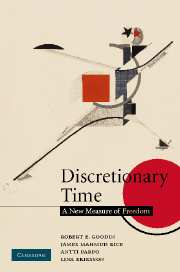Book contents
- Frontmatter
- Contents
- List of figures
- List of tables
- Preface
- Part I Introduction
- 1 Time and money
- 2 Discretionary time and temporal autonomy
- 3 The distribution of discretionary time
- Part II Time pressure
- Part III Welfare regimes matter
- Part IV Gender regimes matter
- Part V Household regimes matter
- Part IV Conclusions
- Appendix 1 Methodology
- Appendix 2 Data
- Bibliography
- Index
3 - The distribution of discretionary time
Published online by Cambridge University Press: 28 October 2009
- Frontmatter
- Contents
- List of figures
- List of tables
- Preface
- Part I Introduction
- 1 Time and money
- 2 Discretionary time and temporal autonomy
- 3 The distribution of discretionary time
- Part II Time pressure
- Part III Welfare regimes matter
- Part IV Gender regimes matter
- Part V Household regimes matter
- Part IV Conclusions
- Appendix 1 Methodology
- Appendix 2 Data
- Bibliography
- Index
Summary
Subsequent chapters will analyse the results of those sorts of calculations in detail, from many different angles. This chapter is offered purely as an introductory sampler, showing the basic sorts of results we get when applying the methodologies just discussed to the MTUS and LIS data sets for the six countries under study.
The aim of the present chapter is threefold. In it, our hope is to show:
There is enough variation – across individuals; across types of persons and households within countries; and across countries themselves – in the amounts of people's discretionary time for those differences to be interesting and important subjects for further discussion.
Although the magnitudes differ from country to country, the basic patterns are sufficiently similar across all these countries to allow us to make certain generalizations without reference to any particular country, as we sometimes will be doing (in chapters 5, 14 and 15).
Although the basic patterns are similar across all the countries, the magnitudes differ sufficiently from one country to another to allow us to make certain inferences about the differential effects of countries' varying welfare regimes and gender regimes (as we do, respectively, in chapters 7–9 and 10–12).
Large variation
At the most general level, we might be concerned just with the average (mean) amount of discretionary time available to people in each of the six countries under discussion. Figure 3.1 reports both the overall average, country by country, and the average broken down by gender.
- Type
- Chapter
- Information
- Discretionary TimeA New Measure of Freedom, pp. 61 - 66Publisher: Cambridge University PressPrint publication year: 2008

